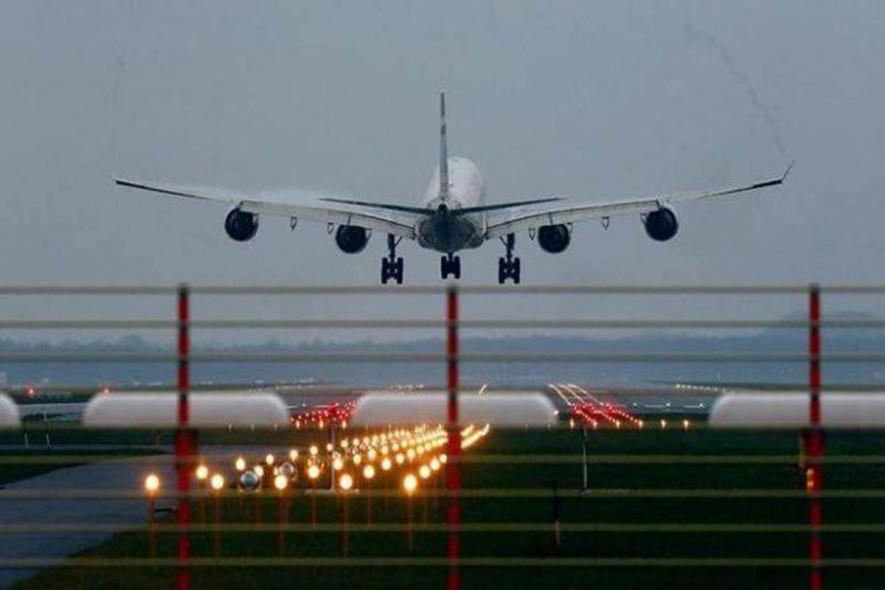Adani’s Plans to Privatise Airports May Go Awry

New Delhi: After signing a binding concession agreement on February 14, 2019, to take over the operations of the international airports at Mangaluru (Karnataka), Lucknow (Uttar Pradesh) and Ahmedabad (Gujarat) from the Airports Authority of India (AAI) within six months, Adani Airports Limited has invoked a “force majeure” clause and requested the AAI to postpone till February 15, 2021, the execution of the agreement it signed with the public sector corporation. The Adani group company has also appointed a consultant to re-evaluate the financial feasibility of running the airports.
A force majeure clause is commonly used in contracts to free contracting parties from liability or obligation when an extraordinary event beyond the control of the parties takes place––such events include a war, an epidemic, a riot, a strike or a development that is often described in legal parlance as an “act of God.”
On June 20, the AAI agreed to extend the deadline for fulfilment of the concession agreement till November 15 this year. The public sector company has reportedly not agreed to extend the deadline for three additional months that Adani Airports Limited had wanted.
The Adani group won a controversial bid in February 2019 to bag the operations of six profit-making international airports in the country operated by AAI, namely, Ahmedabad, Guwahati (Assam), Jaipur (Rajasthan), Lucknow, Mangaluru and Thiruvananthapuram (Kerala).
Due to protests by various employees’ unions and legal disputes, the Adani group has not taken over the running of all the six airports.
The Narendra Modi government’s plan to privatise these profit-making airports, using a public-private partnership (PPP) model, has attracted opposition not only from employees’ unions of the AAI but state governments as well, including the government of Kerala and Rajasthan.
It was reported that after the decision to privatise 15 profitable AAI airports was taken by the Prime Minister’s Office (PMO) in 2018, the Ministry of Civil Aviation (MCA) was tasked to prepare a new model concession agreement in consultation with the Department of Economic Affairs (DEA) in the Ministry of Finance, NITI Aayog and other government ministries.
The MCA, DEA and NITI Aayog were supposed to take into consideration all eventualities, including the feasibility of real estate development in and around the airport complexes.
Working at Breakneck Speed
On November 8, 2018, the Union Cabinet had approved the PMO’s proposal and constituted an Empowered Group of Secretaries (EGoS), headed by Amitabh Kant, chief executive officer, NITI Aayog, to oversee the process of privatisation of six airports. The secretaries of MCA, DEA and the Department of Expenditure (also in the Finance Ministry) were other members of the group.
The EGoS worked at breakneck speed and submitted its report in just over a month.
A few weeks later,on December 10, appraisal notes prepared by NITI Aayog and DEA were forwarded to the CEO of NITI Aayog, the Secretaries to the Department of Expenditure and the Department of Legal Affairs in the Ministry of Law and Justice, together with the Chairman of AAI, informing them that the Public Private Partnerships Appraisal Committee (PPPAC)––the committee that has to clear all PPP projects undertaken by the Union government––was scheduled to meet the very next day, that is, on December 11, 2018, to discuss the proposal relating to the privatisation of six airports managed by AAI.
In his appraisal note, Kumar V Pratap, the then Joint Secretary (Infrastructure Policy & Finance), who represented DEA in the meeting, pointed out serious shortcomings in the documentation.
Pratap’s appraisal note stated that neither MCA nor AAI had submitted a detailed break-up of the estimated project cost, key performance indicators and details about the status and progress of the capital works undertaken by AAI, which would have to be completed by the concessionaire.
The DEA official’s note clearly stated that without these details, it would be difficult for the PPPAC to compare the technical proposals submitted by bidders. It pointed out the “deviation statement from the documents followed for the preparation of the bid documents”––namely, the Request for Quotation (RFQ), the Request for Proposal (RFP) and the Draft Concession Agreement.
In addition, the MCA failed to submit a legal vetting certificate and detailed calculations to support the figures stated in the memorandum to the PPPAC together with the project report. This was considered very important because the numbers mentioned in the PPPAC memorandum on the financial viability of the projects and the AAI’s project report were “vastly different.”
The DEA recommended that one bidder should not get the contract to operate more than two airports because airport development projects are highly capital intensive and the financial risks involved may lead to the concessionaire not fulfilling the requirements of the contract. The department also stressed the need for stringent adherence to performance indicators.
According to DEA, awarding these projects to different companies would enhance competition and also facilitate comparisons among bidders, using clearly defined yardsticks. Moreover, in the event of a project failure, the financial impact on a bidder would be limited and there would be other companies to take over the project.
Pratap’s note cited the example of the GMR group which was the only “qualified bidder” for the privatisation of both the Delhi and the Mumbai airports, but was nevertheless awarded the concession for developing only the Delhi airport, while the development of Mumbai airport was given to the GVK group.
Another example cited by DEA was the privatisation of the electricity distribution network in Delhi that was awarded to three different companies.
None of these suggestions were accepted by the government and the Adani group was able to win the bids for all six airports in February 2019.
Changing the Revenue Model
The revenue sharing model that was adopted when the Delhi and Mumbai airports were privatised during the tenure of the United Progressive Alliance (UPA) government headed by Manmohan Singh, was not adopted on this occasion.
Instead of sharing a pre-decided percentage of the total revenue with AAI, as the concessionaires of the Delhi and Mumbai airports were contracted to, the new round of privatisation was based on a “fee per passenger” model.
(For Delhi airport, the GMR group-led consortium pays 45.99% of the total revenue to AAI while for Mumbai airport, the GVK group-led consortium pays 38.7% of its total revenue.)
As per the new model, the concessionaire would have to pay a pre-fixed amount per passenger to AAI and this figure would be used to determine the winner from among qualified bidders.
This method had its shortcomings because AAI’s revenue would be completely dependent on the volume of passengers in a particular airport. However, for the concessionaire (in this case, the Adani group), there would be considerable revenue- generating options from aeronautical activities, restaurants, cafes, eateries, bars and duty-free shops, in addition to income from advertisements, parking charges and so on.
In addition, the concessionaire would be free to charge a separate user fee from passengers and would also be able to develop the land owned by AAI near these airports.
On top of all these revenue-generating sweeteners in the contract, the biggest attraction for the concessionaire was that, unlike the 30-year contracts between AAI and the consortia led by the GMR and GVK groups, the new concession period was now extended by two decades to 50 years. The AAI would have to pay the depreciated value of the assets created by the concessionaires should it wish to take back the properties, at the end of the lease tenure.
The DEA asked AAI and MCA to submit examples of proposed transaction structures based on a fee per passenger revenue model that were followed by airports in different countries and the benefits such structures had over the revenue-sharing model.
It also wanted the technical and financial capacities of the bidder to be linked with the project cost. Hence,it recommended that the worth of the bidder’s technical capacity must be twice the total project cost (TPC) while the bidder’s financial capacity measured in terms of its net worth should be a fourth of the TPC.
It also wanted “the detailed project financials with all assumptions, including (the) financial model to support the 50 years concession period needs to be submitted” by the AAI and the bidders for comparison and “the concession period should be co-terminus with all the project facilities including city-side development facilities.”
The DEA joint secretary’s note also recommended that the concessionaire should transfer all the assets free of cost to AAI at the end of the tenure of the contract.
It recommended that a license model be followed instead of the proposed lease model and wanted the bidders to submit “all the details, such as project scoping, project sizing, demand supply analysis to ascertain the (financing) gap and to justify the projected revenues and the financial returns and component-wise break-up of project cost with assumption(s)/benchmarks, periodic capital investment, regulatory framework with regard to (the ) AERA (Airports Economic Regulatory Authority) and (the) National Civil Aviation Policy (of) 2016.”
NITI Aayog, in a separate note, agreed with the suggestions and recommendations made by DEA official Pratap.
It recommended that evaluation parameters for selecting the bidder who quoted the highest “per passenger fee” should be changed because the method for calculating such a fee had not been elaborated upon. The reason it cited was that the “actual payment received by the authority (AAI) in this case shall be determined by the actual passenger volume every month/year. Hence during periods of low passenger volume, the receipts shall be adversely impacted.”
NITI Aayog added that from the concessionaire’s perspective, the volume of passengers would only impact part of his revenues and in a scenario where the passenger volume for particular periods are low but other aeronautical revenues are high, the AAI would lose out on the portion of non-passenger related revenues.
The website of Adani group claims the six airports have a combined 225 acres of “attractive land” which is available for “modernisation” and that Adani Airports will have 100% ownership of the assets for 50 years.
Under the gross revenue share model, no party could unilaterally be either disadvantaged or benefitted because of fluctuation in passenger volumes or changes in real estate prices. “In light of this there may be a case to re-consider the financial bid evaluation parameter,” the NITI Aayog note argued, adding that “prior experience in development, operation and management of airports should be made a mandatory criteria to participate in the tender.”
None of these recommendations proposed by DEA and the NITI Aayog (that replaced the Planning Commission) were accepted or found its way into the bid document.
Adani Declared Winner Amid Legal Tussles
A tender was floated two days after the December 11, 2018, meeting of the PPPAC and Adani Airports was declared the winner in all the bids for the privatisation of all six airports serving international flights, that is, Ahmedabad, Guwahati, Jaipur, Lucknow, Mangaluru and Thiruvananthapuram.
There was widespread criticism of the outcome of the bidding process. The opposition Congress party questioned the decisions of the PPPAC and Empowered Group of Secretaries (EGoS) and alleged that the panels of civil servants had acted on behalf of the Modi government to help the Adani group that has no prior experience in the business of operating and managing airports.
The government of Kerala that had initially sought permission to develop the Thiruvananthapuram airport on its own, filed a case in the high court against the Central government’s decision.
It alleged that AAI’s decision to hand over the Thiruvananthapuram airport to a private player was “arbitrary and illegal” and was “attempting to prefer a particular private concessionaire” (the Adani group) that “has no previous experience in managing airports.”
The Kerala government argued that New Delhi’s decision to privatise the airport in the state capital was not in public interest and that the decision violated the provisions of the Airports Authority of India Act, 1994.
The petition pointed out that the Central government had assured the state government in 2003 that it would be consulted before a decision to privatise the Thiruvananthapuram international airport is taken and that this commitment had not been adhered to.
The high court dismissed the Kerala government’s writ petition on the grounds that it was premature and under Article 226 of the Constitution (that empowers the high court to issue writs to any government, authority or person), not maintainable.
The court saidthat whether the state government is within its legal right to challenge the Central government’s policy decision has to be decided by the Supreme Court of India as per Article 131 of the Constitution (that vests the apex court with original jurisdiction over disputes between states and between the Central government and a state government).
The Kerala government then approached the Supreme Court which sent the case back to the high court, where it is still pending.
In Guwahati, a group of persons filed a public interest litigation (PIL) in the high court there well before the bids to privatise the airport in Assam’s capital were opened. Citing various provisions of AAI Act, 1994, the petitioners argued that it was inappropriate to privatise a profit-making public utility.
Because of a stay order issued by the court on February 13, 2019, the financial bid for Guwahati airport was not opened on February 25, along with the bids for other airports. That day, the court ordered: “… in view of the pendency of this petition, the respondent authority shall inform the successful Concessionaire about the pendency of this petition and they being bound by the result of the petition.”
In an interesting, almost comical, aside almost a year later, on March 5, 2019, a bench of Guwahati High Court comprising Chief Justice Ajai Lamba and Justice Soumitra Saikia, rebuked the Assistant General Manager (Finance) of AAI, Sandeep Aggarwal, who was present in court for the hearing, for not being dressed properly.
The bench remarked: “…We find he is inappropriately dressed. He does not even have the courtesy to have worn a tie and jacket. Prima facie he is in contempt.”
The case remains pending in the High Court.
The Congress government in Rajasthan headed by Chief Minister Ashok Gehlot informed the Central government that it would not allow the takeover of the Jaipur Airport by the Adani group.
Will Adani’s Airport Plans Go Awry?
Adani Airports Limited was registered as a corporate entity in Ahmedabad, Gujarat, on August 2, 2019, and is yet to commence business operations. According to a filing by the company’s parent, Adani Enterprises Limited, to the regulator of the country’s financial markets, the Securities and Exchange Board of India (SEBI), the company would be “acquiring, promoting, operating, maintaining, developing, designing, constructing, upgrading, modernising, renovating, expanding and managing airports in India and abroad.”
While the Union government gave its green signal to AAI to sign the concession agreements with Adani Airports in July 2019, the agreements were actually signed only in February this year for three airports, Ahmedabad, Lucknow and Mangaluru.
According to a press release issued by AAI on February 14, the public sector company signed three concession agreements that day for the “operations, management and development” of Ahmedabad, Lucknow and Mangaluru airports through PPP mode with the concessionaires, namely, Adani Ahmedabad International Airport Limited, Adani Lucknow International Airport Limited and Adani Mangaluru International Airport Limited, respectively.
The agreements were signed by B K Mehrotra, executive director, strategic initiative unit on behalf of AAI and Behnad Zandi, CEO – Airports, Adani Enterprises Limited in the presence of Arvind Singh, Chairman, AAI, and other senior officials.
The concessionaires were required to take over the Ahmedabad, Lucknow and Mangaluru airports after fulfilling certain conditions within 180 days from February 14, 2020. It was specified that the concessionaires would pay AAI a per passenger domestic fee of Rs 177 for the airport at Ahmedabad, Rs 171 for Lucknow airport and Rs 115.00 for Mangaluru airport for both embarking and disembarking domestic passengers and twice the amounts in the case of international passengers.
It was mentioned in the press note that the per passenger fee would be revised annually taking into account of the variation in the consumer price index for industrial workers. Further, it mentioned that “the concession fee that the AAI would receive would be utilised for the maintenance and development of other brownfield (or existing) airports and also development of RCS–UDAN and other greenfield (new) airports across the country.”
RCS-UDAN is a bilingual acronym standing for Regional Connectivity Scheme––Ude Desh Ka Aam Nagrik meaning “let the ordinary citizen fly.”
The concession agreements were binding and, according to a top AAI official, who spoke to these writers on condition of anonymity, the new concessionaire has to sign registration and adjudication documents and take possession of the airport within six months.
As already stated, Adani Airports wanted a deferment till February 15, 2021, but has been granted time till November 15 by AAI.
While taking over these three airports, Adani had to pay around Rs 1,000 crore upfront to AAI as asset transfer fees for the three airports. The company has requested a deferment of this payment. Once the airports are taken over, Adani Airports will have to pay contractors for ongoing work assigned to them by AAI.
Meanwhile, latest statistics show that passenger volumes have declined drastically in the two airports of Lucknow and Mangalore, and in Ahmedabad it has grown marginally.
Privatisation of Airports a ‘Mistake’
The travel and tourism industry is facing huge losses after the outbreak of COVID-19. According to a report put out by credit rating agency, ICRA, during the current calendar year, air travel will be around half of what it was in 2019 and will not touch that year’s level before 2023.
A report published by the International Air Transport Association (IATA) says the global air passenger volume is forecast to contract by 50.6% in 2020 and the projection for 2021 is not looking any good. It says the Asia-Pacific region, of which India is a part, is the “worst hit.”
Such a situation will adversely affect AAI’s revenues if the private concessionaire pays only a fee per passenger. This is exactly what the NITI Aayog pointed out in its note to PPPAC.
More significant are the pitfalls of an ideologically-motivated move toward privatisation of airports, which the Modi government seems hell bent on.
Alexandre de Juniac, Director General and CEO, IATA, had on June 2018 stated: “We are in an infrastructure crisis. Cash-strapped governments are looking to the private sector to help develop much needed airport capacity. But it is wrong to assume that the private sector has all the answers. Airlines have not yet experienced an airport privatization that has fully lived up to its promised benefits over the long term. Airports are critical infrastructure. It is important that governments take a long-term view focusing on solutions that will deliver the best economic and social benefits. Selling airport assets for a short-term cash injection to the treasury is a mistake.”
Under the circumstances, it is far from clear if Adani Airports will go ahead with its plans to take over and run the three airports of Ahmedabad, Lucknow and Mangaluru. The company has reportedly appointed an external agency to study and submit a report on the financial viability of entering the airport business at this juncture.
The AAI has not disclosed the penalty clauses, if any, for deferment of its contract with the concessionaire, Adani Airports. If, for whatever reason, the company refuses to take over the three airports after November 15, the question arises as to where the AAI will invoke penalty clauses or accept the company’s claims of force majeure.
If the Adani group does indeed take over these three airports and the passenger volumes do not go up as projected, AAI will end up as losers because the revenue it will earn from the airports at Ahmedabad, Lucknow and Mangaluru will only be the per-passenger fee quoted by the concessionaire in its winning bid.
It goes without saying that the head of the Adani group Gautam Adani is perceived to be close to Prime Minister Narendra Modi.
The writers are independent journalists. The views are personal
Get the latest reports & analysis with people's perspective on Protests, movements & deep analytical videos, discussions of the current affairs in your Telegram app. Subscribe to NewsClick's Telegram channel & get Real-Time updates on stories, as they get published on our website.
























